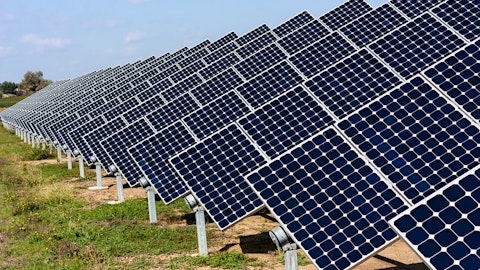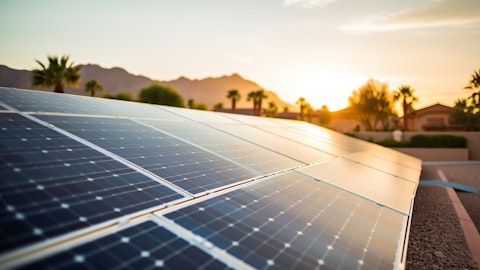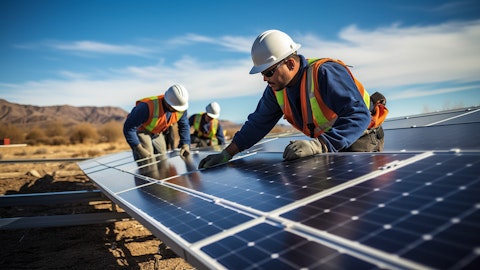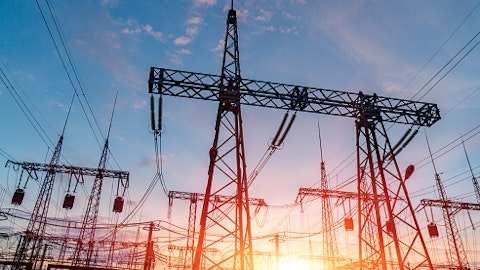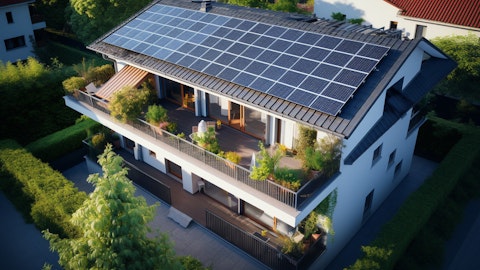Altus Power, Inc. (NYSE:AMPS) Q4 2023 Earnings Call Transcript March 14, 2024
Altus Power, Inc. misses on earnings expectations. Reported EPS is $-0.17089 EPS, expectations were $-0.02. AMPS isn’t one of the 30 most popular stocks among hedge funds at the end of the third quarter (see the details here).
Operator: Good afternoon and welcome to Altus Power’s Fourth Quarter and Full Year 2023 Conference Call. As a reminder, today’s call is being recorded. [Operator Instructions] At this time, for opening remarks and introductions, I would like to turn the call over to Chris Shelton, Head of Investor Relations.
Chris Shelton: Good afternoon and welcome to our fourth quarter and full year 2023 earnings call. Joining me on today’s call are Lars Norell, Co-Chief Executive Officer and Dustin Weber, Chief Financial Officer. In addition, Co-Chief Executive Officer, Gregg Felton, will be joining us for Q&A. This afternoon, we issued a press release and a presentation related to matters to be discussed on this call. You can access both documents on our website, www.altuspower.com, in the Investors section. This information is also available on the SEC’s website. As a reminder, our comments on this call may contain forward-looking statements. These forward-looking statements refer to future events, including Altus Power’s future operations and financial performance.
When used in this call, the words expect, believe, will, plan, forecast, estimate and similar expressions as they relate to Altus Power identify a forward-looking statement. These statements are subject to various risks and uncertainties, which could cause actual results to differ materially from those predicted in the forward-looking statements. Altus Power assumes no obligation to update these statements in the future or if circumstances change, except as required by law. For more information, we encourage you to review the risks, uncertainties and other factors discussed in our SEC filings that could impact these forward-looking statements, specifically our 10-K filed today with the SEC. During this call, we will also refer to adjusted EBITDA and adjusted EBITDA margin, which are non-GAAP financial measures.
We are also introducing a new non-GAAP measure, annual recurring revenue, or ARR, which we will discuss later on in this call. ARR is an estimate that management uses to determine the expected annual revenue potential of our operating asset base at the end of the calendar year. ARR assumes customary weather, production, expenses and other economic market conditions as well as seasonality. We are unable to provide a reconciliation from GAAP to ARR. Our management team uses all of these non-GAAP financial measures to plan, monitor and evaluate our financial performance, and we believe this information may be useful to our investors. These non-GAAP financial measures exclude certain items that should not be considered as a substitute for comparable GAAP financial measures.
Altus Power’s methods of computing these non-GAAP financial measures may differ from similar measures used by other companies. More detailed information about these measures and a reconciliation from GAAP to adjusted EBITDA and adjusted EBITDA margin is contained in both the press release and the presentation that we issued today. With that, I will now turn the call over to Lars for his prepared remarks.
Lars Norell: Thanks, Chris, and welcome to our call. In a challenging environment, we’re very happy to be speaking to you at the end of a record year for Altus Power. We built Altus to be a clean power company and we architected our platform with the goal to be both resilient and nimble to create value for customers and investors in any market climate and the capacity to take advantage of opportunities when they arise. From the beginning, we have focused on recruiting and retaining what we believe to be the best team in the industry with best-in-class access to capital to deliver value to our customers and shareholders. As highlighted on Page 3 of our presentation, our team continued to execute in 2023. And we notched a number of achievements that are testament to the growth available in our expanding market segment and the strength and momentum of our company.
We became the leader of our markets as the largest owner-operator of commercial solar in the country, and we’re starting to see the benefits that a category leader enjoys. We are a customer-centric company that generates and delivers clean power every day. We grew our enterprise customers by over 50%, and we forecast that our portfolio in operation as of year-end will generate over 1 billion kilowatt hours for those customers this year. We’re also growing our capability to serve those customers faster and better. For example, with Altus IQ, which is our AI-enabled software that, among other things, helps our customers measure their carbon footprint. We also had a record year for asset additions totaling 426 megawatts, of which approximately 74 megawatts were new build assets, an output which we are looking to grow further in 2024.
Our very significant asset growth during the year expressed, as expected, annual recurring revenue, equals $183 million. A new metric, as noted earlier. We’re pleased with the visibility towards 2024’s revenue target that this ARR number provides to market and intend to make use of it as we continue on our mission to educate investors. For details on the revenue and adjusted EBITDA growth during the fourth quarter and for the full year 2023, please turn to Page 4. Dustin will go into more detail in a moment, but we ended the year with $155 million of revenue, GAAP net income of negative $26 million, and $93.1 million of adjusted EBITDA. While that adjusted EBITDA number is a record for Altus, an indicative of significant growth at 59% over the prior year’s number, it’s not where we expect it to be for the full year, and the difference is driven by three factors.
The first and primary driver, we were surprised by the stubbornly bad weather across most parts of the country during the fourth quarter. Recalling that the amount of sunshine we harvested in Q3 was on the light side as well. Based on our 15 years of operating history, it’s rare to see two consecutive quarters below norm, but that happened in Q4 of 2023. Second, the operational downtime of portions of our portfolio was higher in the fourth quarter than our historical norm. Outages can be unpredictable when they happen, but by adding technical staff in the field and building out an active component and inventory of spare parts system, we are cutting repair lead times and bringing operations to normal levels. Third, we experienced delays in the onboarding of assets, those that are new builds as well as those we onboard that are already in operation.
While some of these delays relate to overtaxed utility interconnection crews and building departments, an element of it reflects our organization being stretched a little thin from the significant asset growth we’re experiencing. We consider this to be temporary, and we are actively adding to our construction and asset servicing platform to better execute on the growth opportunities available to us. Turning now to Page 5 and looking forward to 2024, taking a range of weather and system performance parameters into account, and for the first time offering a view on revenue, we are projecting that our 2024 revenue will be in the range of $200 million to $222 million. We are further projecting that this will result in 2024 adjusted EBITDA in the range of $115 million to $135 million.
Our cash generation is an important source of funding for Altus, and we expect to take cash from operations and reinvest them into additional customer engagements and solar assets with the intention to drive further growth in these metrics in future years. Importantly, we believe we are positioned to execute our growth plan in 2024 without the issuance of dilutive equity. Our adjusted EBITDA projection for 2024 also includes growing our SG&A budget to reflect our efforts to put in place the capabilities that will continue to set us apart and allow us to retain and expand our market leadership position. On the next slide, Page 6, you will find our growing asset base in operation and pipeline of growth assets that we expect for 2024. We are currently pursuing over 1 gigawatt of new build opportunities and assets in operation, both of which when constructed or closed, would allow us to begin delivering clean power under long-term contracts with our customers.

We relentlessly apply our playbook for large enterprises that are coming to us from CBRE, Blackstone or other channels, and we seek to continuously refine our approach to speed up the client engagement process, but we’re frustrated that some contracting times remain elongated or in the case of community solar that the implementation of announced state programs have gotten delayed. At the same time, we are encouraged with the number and volume of large property owners that are choosing to enter programmatic partnerships with Altus, and we continue to build out our construction platform to have the capability to deliver on that growing new-build flow. In the meantime, we are using that same engineering and construction know-how and horsepower to due diligence and onboard operational assets.
Our sector continues to consolidate and our December acquisition of the Unico platform, pipeline and customer relationships exemplifies Altus’ intention to play a leading role in that consolidation. Further, we continue to see an attractive pipeline of acquisitions of assets in operation. For example, in January, we closed the transaction with Vitol, which adds 20 municipal, school and enterprise clients and another 2,000 community solar customers to our portfolio. As our portfolio approaches 1 gigawatt in size, we are seeing the increased benefits of being a larger platform, including the ability to more efficiently service our customers and assets. Turning now to Page 7 and before handing over to Dustin, I’d like to highlight some themes from our segment to the market and some of the things that we’re focused on for this year.
As we said upfront, we continue to see robust appetite for clean electric power from commercial tenants and strong demand for the associated decarbonization benefits and ancillary income available to landlords. In these market conditions, we are really pleased with the superior unit economics available in commercial solar. Between rate tariffs available to commercial clients and the retail rates that our community solar customers pay, our customers continue to pay a lot for power. As a consequence, Altus continues to be able to deliver meaningful value to our customers while benefiting from very attractive unit economics on our assets. We are starting to observe the benefits of our market leadership position. For example, we enjoy greater brand recognition with tenants and landlords.
We receive more inbound calls from potential channel partners in markets we’ve just entered, and we believe that we are seeing most of the available opportunities in our market. Finally, as Altus Power matures as a public company, we want to continue to refine and improve our market communication. We take seriously the importance of investor education and the additional disclosures that we are presenting today are intended to provide greater clarity into the business. We are also very pleased to announce that our first Investor Day will take place on May 14. We look forward to interacting with market participants at this event and outlining our long-term strategic vision and multi-year growth plan. We will also provide greater details on all the important areas of the Altus platform with a focus on our technical competencies, like our expertise in physical assets as well as our digital capabilities.
With that, I’m happy to hand over to Dustin for details on the numbers. Dustin?
Dustin Weber: Thanks, Lars, and thanks to our investors and analysts for joining the call today. Please join me on Slide 8 as I cover our financial highlights for 2023. Starting with the fourth quarter, our operating revenues grew to $34.2 million compared to $26.8 million in the fourth quarter of 2022, an increase of 28%. For the full year, we achieved a record $155.2 million of operating revenues, up from $101.2 million in 2022, an increase of 53%. Both fourth quarter and full year revenue growth was driven primarily by new additions to our portfolio. Turning to GAAP net income for the quarter, we posted a net loss of $40 million compared to net income of $67.1 million during the fourth quarter of 2022. This variance was primarily the result of a non-cash loss of $17.7 million from the fair value re-measurement of our alignment shares versus a gain of $70.7 million during the fourth quarter of 2022.
This same remeasurement was also a driver for the full year 2023, resulting in net loss of $26 million compared to net income of $52.2 million for 2022. You should continue to expect a quarterly mark-to-market of our alignment shares, which will largely be dependent on the change in our share price during the period. Moving to adjusted EBITDA, we reported $17.3 million for the fourth quarter of 2023 compared to $16.6 million in fourth quarter of 2022, an increase of 5%. As Lars discussed, fourth quarter weather continued the trend we described during our third quarter call and was the primary driver of kilowatt hours coming in below our 2023 expectations. For the full year, adjusted EBITDA amounted to $93.1 million compared to $58.6 million in 2022, still representing a 60% growth.
Despite headwinds from weather, we continue to drive profitability with adjusted EBITDA margin achieving 60% during 2023, an increase compared to 58% from 2022, driven by the economies of scale benefits from our larger operating portfolio. Please turn to Slide 9 for our 2024 guidance of full year revenues and adjusted EBITDA. In addition, to provide greater visibility into our forward expectations, we’re happy to also be providing year-end ARR metric, which we think will help you understand how management looks at performance of our business. We intend to drill down further into financial metrics during our Investor Day in May, including the composition of our ARR, which is our estimated production measured in kilowatt hours, times an estimated average price that we sell kilowatt hours to our customers.
For our 896 megawatts of assets in operation at year-end 2023, we expect $183 million of annual recurring revenues. We add to that the assets closed in Q1, predominantly those associated with our acquisition of Vitol as well as forecasted revenue growth associated with other assets, we expect to add to our operating portfolio throughout 2024. Altogether, we expect 2024 revenue to fall in the range of $200 million to $222 million, which represents a 36% increase over 2023 at the midpoint; and adjusted EBITDA to fall in the range of $115 million to $135 million, an increase of 34% at the midpoint. We believe this guidance range appropriately incorporates our experience in 2023 and allows for a wider range of variability in key drivers impacting generation; notably, forecasted sunlight hours and system availability.
Turning to Slide 10 which highlights our demonstrated access to capital in the fourth quarter. To start, we closed a $200 million construction facility with Blackstone, which provides significant flexibility as it can be drawn for projects at any phase, whether during development, construction or operating. Next, we announced $163 million upsize of our Blackstone term loan facility, which provided long-term financing for both our Basalt acquisition as well as many of our recently-completed assets. Finally, we welcome Goldman Sachs and Canadian Pension Plan as capital providers with a closing of a new $100 million Holdco financing. We believe this efficient financing positions us to continue increasing our market share and executing on the robust growth opportunities available to us.
Moving to Slide 11 to review our expected funding plan. We continue to have no plans to issue dilutive equity or equity-like securities to finance our growth plan. Our successful execution of multiple financings in the fourth quarter has positioned us with a strong cash position of $219 million to end the year, which allowed us ample flexibility to close the Vitol acquisition in January. We plan to fund our remaining 2024 growth plan with a combination of funds from our Blackstone term funding facility, tax equity partnerships and cash from the balance sheet. As our development and construction activity continues to expand, our working capital needs are able to be funded by the new construction facility as well as our corporate revolving credit facility.
Once these projects are completed and begin delivering clean energy to our customers, we plan to utilize our term loan funding facility, which carries a long-term fixed rate on borrowings at 200 basis points to 250 basis points spread over the prevailing 10-year treasury rate. In summary, we believe the strength of our balance sheet and existing sources of capital position us to take advantage of the robust growth opportunities available to us. Thanks to our industry leading platform which generates significant cash flow and has access to the necessary financing to support our growth. That concludes my review of our financials. And with that, we are ready to take your questions.
See also 12 Fastest Declining Cities in Florida and 10 Biggest Smartwatch Companies in the World.
Q&A Session
Follow Altus Power Inc.
Follow Altus Power Inc.
Operator: Thank you. [Operator Instructions] Our first question today is coming from the line of Andrew Percoco with Morgan Stanley. Please proceed with your questions.
Andrew Percoco: Hi, thanks so much. Thanks for taking the question. I guess maybe to start out with the guidance. Thanks for giving this annual recurring revenue number. Can you maybe just help us bridge the gap to the 2024 guidance range, maybe both for revenue but also for adjusted EBITDA? I think last year, you gave us kind of an exit PAR number. Is the right way to kind of maybe think about that is, maybe just apply the 2023 adjusted EBITDA margin against the ARR and then kind of comp that to the 2024 guidance range, and then it still seems like there would be a delta. Can you just maybe give us a sense for what gets you to the middle of the range? Are you still on track for the 150 megawatts that you’re planning to bring online and how much of that will be driven by additional acquisition?
Gregg Felton: Sure. Hey, Andrew, let me kick this off. This is Gregg, and perhaps Dustin will chime in as well. So thanks for the question. The first point I think we should make is that we are very focused on increasing the visibility into our business, and we’ve taken deliberate steps to make Altus easier for our investors to understand and model. We think this first idea of producing not only annual revenue guidance, but also introducing annualized recurring revenues, or ARRs, is a very important element in order to facilitate modeling, specifically as we’re also introducing annual expected production of in place operating assets. So that baseline of ARR should feature prominently in the modeling. And of course, that leaves the annual growth wedge.
And in addition to our annual guidance, we’ll be focused on giving you the tools necessary to understand our longer-term opportunity and visibility as it relates to any large acquisitions that we might make. We’re intending to provide disclosure around those as well. And just the final point I’ll make is that on our first Investor Day in May, we intend to cover a number of other areas of our business that haven’t yet been on full display for investors, and we’re looking forward to sharing insights on our technical capabilities and capabilities as it relates to not only physical assets but also the technology. So there’s a lot more disclosure that we’re looking to provide and a lot more visibility we’re looking to provide, specifically to allow you to take that ARR and bridge it forward over the next – not only this year, but beyond.
Dustin, do you want to add anything to that?
Dustin Weber: No, I think you summarized it well, Gregg. I would just add that we think ARR highlights the power of our recurring nature of our long-term customer relationships. And we think it’s informative and it provides visibility and building blocks from 2023 results to our 2024 guidance. Gregg talked about the growth wedge, that can come in a lot of forms for us, where we could add larger amount of megawatts later in the year and kind of fill that growth wedge or we could add a smaller amount earlier in the year that would contribute more meaningful to the ‘24 revenues.
Gregg Felton: And let me maybe just also – you asked about just the texture perhaps of the opportunities that we’re seeing, and there’s a significant flow of opportunities that are available to us, and we fully expect to extend our leadership position in commercial scale solar. So, on the new build side, we do expect to increase our construction cadence in 2024 from what was a record of 74 megawatts last year. And then as it relates to acquisitions of assets in operation, we are seeing a robust flow of consolidation opportunities, which should grow our market share. Of course, we closed on one such acquisition in Q1, and there are more in our pipeline that we are pursuing as well.
Andrew Percoco: Understood. That’s super helpful context. And then maybe as a follow-up to that, can you maybe just give us an update on your return thresholds? Is there an opportunity to increase your returns from here? You kind of talked about brand recognition, the power of the platform in some of the prepared remarks. And I think across the utility scale solar development landscape, we are starting to see some targeted increases in returns from some of the larger players. I’m just curious if that’s the potential read-through to the C&I space.
Gregg Felton: Yes. I think that there is no question that the financing environment, specifically as it relates to higher interest rates, should and is translating into higher return opportunities. So, without question, we are seeing that today, and we expect to see that throughout this year. Maybe I’ll take the opportunity on the back of that to talk about a little bit of just the environment that we’re seeing, Andrew, because it’s no secret that some market participants are experiencing the pitfalls associated with a lack of cash flow generation and capital structures that are also stressed by the current higher interest rate environment. And as you know, that profile translates into dilutive equity issuances, or even worse in some cases, legitimate questions about the viability of a business.
We, on the other hand, benefit from a number of key structural advantages. As a starting point, one of the biggest differences is our business generates cash flow from existing operations, and also, we only invest capital when there are attractive growth opportunities. And to your question, that, of course, means not only attractive growth in terms of things that are in front of us, but they have to meet the return thresholds that make sense in the context of the current environment. We – there are a variety of other things that we can detail and we’ll go into those on Investor Day, but it is critical for me to highlight that we built our business also to have durable access to world-class financing and we’ve consistently shown our ability to efficiently access capital, not only in terms of our ongoing access to the Blackstone funding facilities, but also the very recent and attractively priced financing from our partners at Goldman and Canadian Pension Plan.
